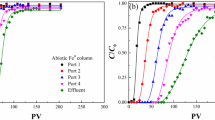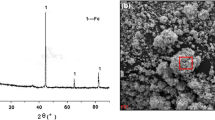Abstract
Kinetics of simultaneous iron and polychlorophenol (CP) oxidation by groundwater enriched cultures were studied in laboratory and during actual remediation in orderto reveal the fate and effects of iron on aerobic on-site bioremediation of boreal groundwater. 2,4,6-tri- (TCP), 2,3,4,6-tetra- (TeCP) and pentachlorophenol (PCP)were degraded in fluidized-bed bioreactor (FBR) by over 99%, over 99%, and over96%, respectively. The oxygen consumption rate for CP-biodegradation was 1.31μmol DO L-1 min-1 and 0.29 μmol DO L-1 min-1 for iron oxidation, i.e. approximately 12% of the oxygen was consumed by iron oxidation during normal FBR operation. Mineralization of CPs was confirmed by DOC removal and chloride release of 158% and 78%, respectively. Excess DOC removal was due to partial degradation of the natural organic matter (NOM) (1.1 mg L-1 or 24% DOC removal) in the groundwater. Removal of NOM consumed 0.91 μmol DO L-1min-1. Iron oxidation in the FBR was over 94% of which chemical Fe(II) oxidation accounted for up to 10%. Fe(III) partially accumulated (58 to 69%) in the system. The TCP- and CP-biodegradation consumed DO at two times higher rates than the Fe(II)-oxidation in both, laboratory and full-scale, respectively. The batch assays atvarious TCP and Fe(II) ratios and DO concentrations showed simultaneous oxygenconsumption by TCP and Fe-oxidizers and that increased Fe concentrations do notoutcompete the bioremediation of CP's for available oxygen.
Abbreviations: DAPI: 4',6'-Diamidino-phenylindole; DO:Dissolved oxygen; DOC: Dissolved organic carbon; FBR: Fluidized-bed bioreactor;HRT: Hydraulic retention time; NOM: Natural organic matter; PCP: Pentachlorophenol; SEM: Scanning-electron microscopy, TeCP: 2,3,4,6-Tetrachlorophenol; TCP: 2,4,6-Trichlorophenol
Similar content being viewed by others
References
APHA (1992) Standard methods for the examination of water and wastewater. American Public Health Association (APHA), American Water Works Association and Water Environment Federation, Washington, DC
Appelo CAJ & Postma D (1996) Geochemistry, groundwater and pollution. (pp 311-312). Balkema, Rotterdam
Chapelle FH (2001) Ground-water microbiology and geochemistry. 2nd edn, (pp 292-320). John Wiley & Sons, Inc., New York
Coleman AW (1980) Enhanced detection of bacteria in natural environments by fluorochrome staining of DNA. Limnol. Oceanogr. 25: 948-951
Czekalla C (1997) Biological oxidation of iron and manganese-Process engineering and operational aspects. bbr 48: 22-27 (in German)
Czekalla C & Kotulla H (1990) Change of the water works Westerbeck of the Stadtwerke Wolfsburg AG to aerobic biological iron removal. gwf Wasser Abwasser 131: 126-132 (in German)
Czekalla C & Wichmann K (1994) Biodegradation of organic hazardous chemicals in iron removal facilities. gwf Wasser Abwasser 135: 207-212 (in German)
Czekalla C, Mevius W & Hanert H (1985) Quantitative removal of iron and manganese by microorganisms in rapid sand filters (in situ investigations). Wat. Supply 3: 111-123
Eble W, Saggau D & Beitz H (1999) Combination of In-situ and Onsite processes for groundwater remediation. TerraTech 45-49 (in German)
Emerson D & Revsbech NP (1994) Investigation of an Iron-Oxidizing microbial Mat Community Located near Aarhus, Denmark: Laboratory Studies. Appl. Environ. Microbial. 60: 4032-4038
Ghiorse WC (1984) Biology of iron-and manganese-depositing bacteria. Ann. Rev. Microbiol. 38: 515-550
Hallbeck L & Pedersen K (1990) Culture parameters regulating stalk formation and growth rate of Gallionella ferrugenia. J. Gen. Microbiol. 136: 1675-1680
Hanert H (1981) The Genus Gallionella. In: Balows A, Trüper HG, Dworkin M, Harder W & Schleifer K-H (Eds), The Prokaryotes, 2nd edn (pp. 4082-4088). Spinger-Verlag, New York
Hatva T (1989) Iron and manganese in groundwater in Finland: Occurrence in glacifluvial aquifers and removal by biofiltration. Publication No. 4, National Board of Waters and the Environment, Helsinki, Finland
Hässelbarth U & Lüdemann D (1971) Biological iron and manganese removal. Vom Wasser 38: 223-253 (in German)
Järvinen K (2001) Bioreactor treatment of chlorophenol contaminated groundwater in Kärkölä. Series: The Finnish Environment 506. Uusimaa Regional Environment Centre, Helsinki (in Finnish)
Järvinen KT & Puhakka JA (2002) Full-scale on site bioremediation of polychlorophenol contaminated groundwater at low temperature. (submitted)
Kästner M & Hofrichter M (2001) Biodegradation of Humic Substances. In: Steinbüchel A (Ed) Biopolymers Biology, Chemistry, Biotechnology, Applications (pp 249-378). Wiley-VCH, Weinheim, Germany
Kujala-Räty K, Hiisvirta L, Kaukonen M, Liponkoski M & Sipilä A (1998) Household water quality in Finland in the year 1996. The Finnish Environment 181, Ministry of Social Affairs, Ministry of Agriculture and Forestry, Ministry of the Environment, Finnish Environment Institute, Helsinki, (in Finnish)
Langwaldt JH, Männistö MK, Wichmann R & Puhakka JA (1998) Simulation of in situ subsurface biodegradation of polychlorophenols in air-lift percolators. Appl. Microbiol. Biotechnol. 49: 663-668
Langwaldt JH & Puhakka JA (1999) Simulation of in situ chlorophenol-bioremediation from groundwater in pilot scale. In: Alleman BC & Leeson A (Eds) Bioremediation of Nitroaromatic and Haloaromatic Compounds Vol. 5(7) (pp 113-117). Battelle Press, Columbus, OH
Langwaldt JH & Puhakka JA (2002) Competition for oxygen by iron and 2,4,6-trichlorophenol oxidizing bacteria in boreal groundwater. Wat. Res. (in press)
Lüllmann H & Schattney S (1993) Combined technologies in use. TerraTech 41-43 (in German)
Lütters-Czekalla S (1990) Lithoautotrophic growth of the iron bacterium Gallionella ferruginea with thiosulfate and sulphide as energy source. Arch. Microbiol. 154: 417-421
Mäkinen PM, Theno TJ, Ferguson JF, Ongerth JE & Puhakka JA (1993) Chlorophenol toxicity removal and monitoring in aerobic treatment: Recovery from process upsets. Environ. Sci. Technol. 27: 1434-1439
Männistö MK & Puhakka JA (2002) Psychrophilic and microaerophilic bacteria in boreal groundwater. FEMSMicrobiol. Ecol. 41: 9-16
Männistö MK, Tiirola MA, Salkinoja-Salonen MS, Kulomaa MS & Puhakka JA (1999) Diversity of chlorophenol-degrading bacteria isolated from contaminated boreal groundwater. Arch. Microbiol. 171: 189-197
Männistö MK, Tiirola MA & Puhakka JA (2001a) Degradation of 2,3,4,6-tetrachlorophenol at low temperature and low dioxygen concentrations by phylogenetically different groundwater and bioreactor bacteria. Biodegradation 12: 291-301
Männistö MK, Salkinoja-Salonen MS & Puhakka JA (2001b) In situ polychlorophenol bioremediation potential of the indigenous bacterial community of boreal groundwater. Wat. Res. 35: 2496-2504
Melin ES, Järvinen K & Puhakka JA (1998) Effect of temperature on chlorophenol degradation kinetics in fluidized-bed reactors using different carrier materials. Wat. Res. 32: 81-90
Morita RY (1997) Bacteria in Oligothrophic Environments, Starvation-Survival Lifestyle. Chapman & Hall, New York
Mouchet P (1992) From conventional to biological removal of iron and manganese in France. J. Am. Water Works Assoc. 84: 158-167
Nystén T (1994) Mathematical Modelling of Groundwater Pollution in a Small Heterogeneous Aquifer in Kärkölä, Southern Finland. Publications of the Water and Environment Research Institute 15, National Board of Waters and the Environment, Helsinki, Finland
Omura T, Umita T, Nenov V, Aizawa J and Onuma M (1991) Biological oxidation of ferrous iron in high acid mine drainage by fluidized bed reactor. Wat. Sci. Tech. 23: 1447-1456
Petermann-Herman A, Kasche V & Mahro B (1992) Comparison of different process for introduction and extraction of bacteria to and from soil. In: Behrens D & Wiesner J (Eds) Mikrobiologische Reinigung von Böden (pp 369-376). DECHEMA, Frankfurt am Main, Germany (in German)
Ramsay AJ (1984) Extraction of bacteria from soil: Efficiency of shaking or ultrasonication as indicated by direct counts and autoradiography. Soil Biol. Biochem. 16: 475-481
Ranville JF & Macalay DL (1997) Natural organic matter in catchments. In: Saether OM & de Caritat P (Eds), Geochemical processes, weathering and groundwater recharge in catchments (pp 263-303). Balkema, Rotterdam
SFS (1976) Finnish Standards Association, SFS 3028: Determination of Iron in Water. Photometric Method. Helsinki, Finland.
Sjölund M (1999) The effect of humic substances on biological remediation of chlorophenol contaminated aquifer. MSc thesis. Tampere University of Technology, Tampere, Finland (in Finnish)
Søgaard EG, Medenwaldt R & Abraham-Peskir JV (2000) Conditions and rates of biotic and abiotic iron precipitation in selected Danish freshwater plants and microscopic analysis of precipitate morphology. Wat. Res. 34: 2675-2682
Søgaard EG, Aruna R, Abraham-Peskir J & Koch CB (2001) Conditions for biological precipitation of iron by Gallionella ferruginea in a slightly polluted ground water. Appl. Geochem. 16: 1129-1137
Stumm W & Lee GF (1961) Oxygenation of Ferrous Iron. Ind. Eng. Chem. 53: 143-146
Tiirola MA, Männistö MK, Puhakka JA & Kulomaa MS (2002). Isolation and Characterization of Novosphingobium sp. Strain MT1, a Dominant Polychlorophenol-Degrading Strain in a Groundwater Bioremediation System. Appl. Environ. Microbiol. 68: 173-180
Zettler B (1996) In situ remediation of an aquifer contaminated with chlorinated aromatics. Microbiological and toxicological studies and mass balance of the contaminant fluxes. Hygiene Berlin, Technical University of Berlin, Berlin, Germany (in German)
Author information
Authors and Affiliations
Rights and permissions
About this article
Cite this article
Langwaldt, J.H., Puhakka, J.A. The oxidation, fate and effects of iron during on-site bioremediation of groundwater contaminated by a mixture of polychlorophenols. Biodegradation 13, 317–328 (2002). https://doi.org/10.1023/A:1022323622818
Issue Date:
DOI: https://doi.org/10.1023/A:1022323622818




